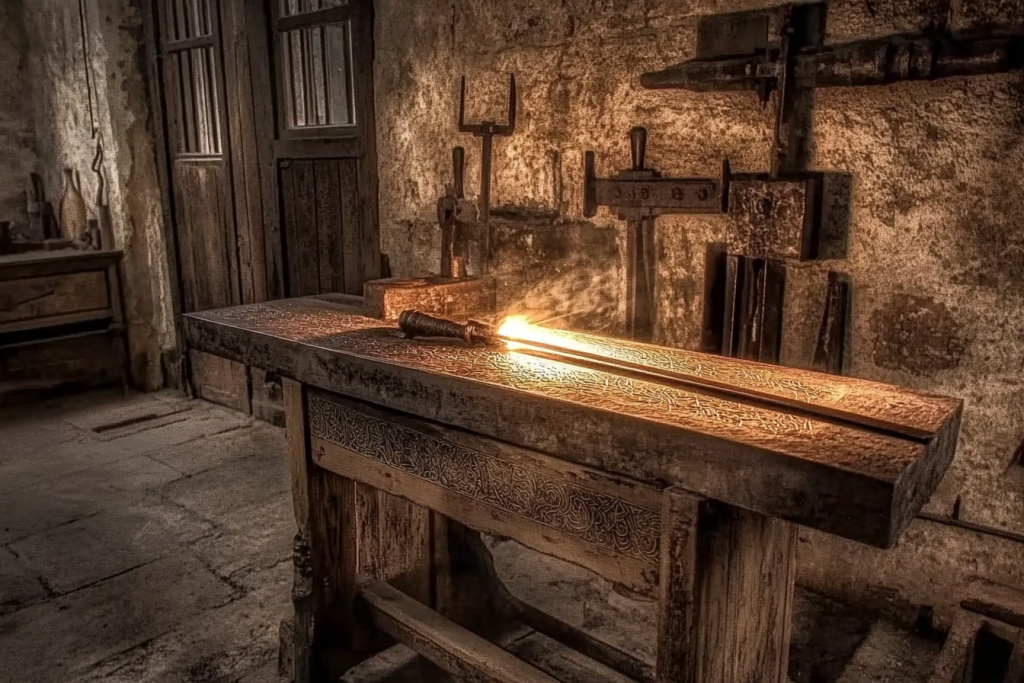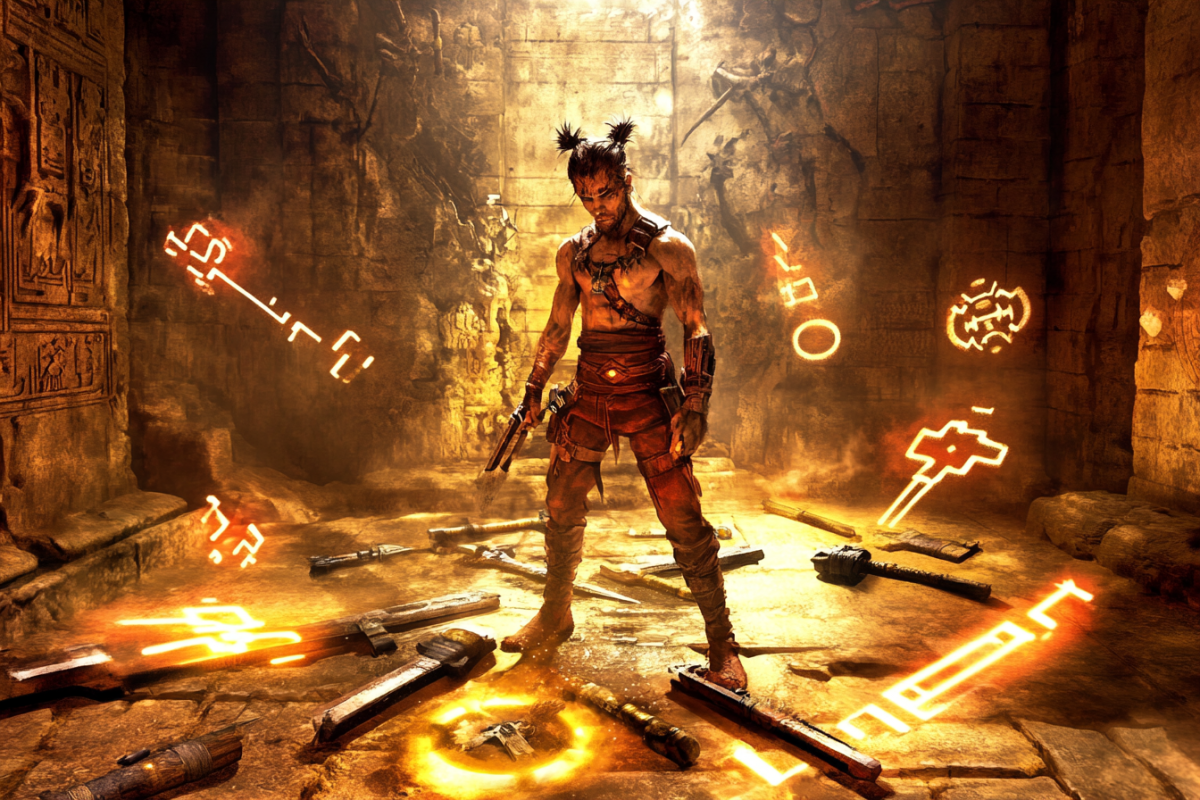
Across the ruins of lost civilizations and buried battlefields, archaeologists have unearthed weapons that defy explanation. Some are too advanced for the era they came from, forged with forgotten techniques or made from materials that shouldn’t have existed. These mysterious artifacts challenge what we know about ancient technology—and hint at secrets long buried in the past. Whether crafted by unknown masters or left behind by something even stranger, these weapons were never meant to exist… and yet they do.
The Ulfberht Sword

Discovered across Europe, these Viking-age swords bear a mysterious inscription—“+ULFBERH+T”—and were made with steel of such high purity that it wouldn’t be seen again until the Industrial Revolution. How did medieval blacksmiths master such metallurgical precision? Some suggest lost knowledge, while others whisper of Eastern trade secrets or outside intervention. Either way, these blades were centuries ahead of their time.
The Damascus Steel Blades

Damascus steel weapons were famed for their strength, flexibility, and ability to slice through other metals with ease. Crafted in the Middle East over a thousand years ago, their exact manufacturing process has been lost. The swirling patterns on the blades aren’t just beautiful—they’re a mark of an advanced forging technique that modern science still struggles to replicate. Legends claim they could split hair midair or cleave through rifle barrels.
The Iron Pillar of Delhi’s Spearhead

The Iron Pillar of Delhi has baffled scientists for centuries due to its resistance to rust—but an even more puzzling discovery lies in its origins. Some believe it was once topped with a ceremonial spearhead or weapon, forged with a technique immune to time. Metallurgical analysis shows a composition far beyond what was thought possible for ancient Indian smiths. Its corrosion-resistant alloy remains an unsolved mystery.
The Antikythera Mechanism’s Gear-Embedded Arrowhead

Fragments of the Antikythera Mechanism—a device often called the world’s first computer—were found alongside strange, gear-embedded bronze arrowheads. These hybrid artifacts suggest weapons with mechanical functions, far beyond simple point-and-shoot. Could they have been used for calculating trajectory or range? If true, it means ancient warriors may have wielded smart tech thousands of years ago.
The Shardana Bronze Swords

Unearthed in Sardinia, these perfectly balanced bronze swords were wielded by the mysterious Sea Peoples. Despite the limitations of bronze, the craftsmanship rivals iron weapons from centuries later. Their design and metallurgy point to a vanished civilization with superior military technology. No one knows who the Shardana really were—or where their knowledge came from.
The Naqada Maceheads of Egypt

Found in predynastic tombs, these Egyptian maceheads are made from hard, polished stone and carved with impossible precision. Their balance, weight, and design suggest ceremonial use—but some show signs of actual combat. The tools needed to create such fine detail simply didn’t exist at the time. Did the ancient Egyptians inherit lost techniques from an earlier civilization?
The Chinese Repeating Crossbow

This ancient weapon could fire arrows in rapid succession, centuries before the invention of modern firearms. Invented during the Warring States period, it featured a simple yet ingenious design that allowed for semi-automatic shooting. Such a level of mechanical innovation seems centuries too early. Even today, replicas show it was surprisingly effective in battle.
The Celtic “Dragon Slayer” Sword

Excavated from a bog in Ireland, this oversized iron sword is far too large and heavy for any known soldier of the era. Its proportions suggest either a ceremonial weapon—or the existence of warriors much stronger than we believed. Some believe it belonged to a legendary champion, while others think it was designed for something not entirely human. No historical records explain its creation.
The Japanese Muramasa Blades

Forged by the legendary swordsmith Muramasa, these katanas were said to thirst for blood—compelling their wielders to violence. While the legends may be exaggerated, metallurgical studies show an extraordinary level of craftsmanship. The blades are incredibly sharp, resilient, and perfectly tempered, even by today’s standards. Some believe Muramasa used lost forging rituals that bordered on the supernatural.
The Baghdad Battery Weapon Theory

Among the ruins of ancient Mesopotamia, clay jars with copper and iron rods were found—dubbed the “Baghdad Batteries.” While often thought to be early electrical devices, some theorists believe they powered crude electroplated weapons or shock-based defenses. No such weapons have been confirmed, but the implication is staggering. Electricity in the ancient world could mean our ancestors were experimenting far beyond their time.
The Greek Fire Projectors

A terrifying weapon of the Byzantine Empire, Greek Fire could burn even on water—and its formula has been lost for centuries. More shocking is the rumored existence of handheld projectors used to spray the substance in battle. These would have operated like early flamethrowers, something thought impossible for the era. No complete device has ever been found, but fragments suggest they once existed.
The Andes Obsidian Daggers

Found in the high mountains of Peru and Bolivia, these obsidian daggers are sharper than surgical steel and carved with haunting precision. They cut cleaner than metal, and their handles are adorned with strange symbols and unknown materials. How ancient tribes carved volcanic glass so perfectly remains unsolved. Some suggest these were ritual weapons—others think they were tools of ancient elites.
The Hidden Blades of the Scythians

Buried with Scythian warriors were intricate folding knives and hidden blades, centuries ahead of their time. Some featured spring mechanisms that resemble modern switchblades. How nomadic horsemen mastered such fine engineering remains unclear. Their weaponry reveals a complex society with knowledge of mechanics few other cultures had.
The Stone Spheres of Costa Rica (as Weapons?)

While often considered ceremonial or astronomical, some researchers believe the perfectly round stone spheres found in Costa Rica may have once served as massive projectile weapons. Their size and precision are mind-boggling—some weighing tons, yet nearly flawless in shape. Were they ancient artillery, meant to crush enemies from afar? Their true purpose remains a mystery.
The Crystal Dagger of the Atlanteans

Discovered in the depths of the Mediterranean, this translucent dagger is carved entirely from a single piece of quartz crystal, yet it’s sharper than steel and seemingly unbreakable. Its design doesn’t match any known culture, and some believe it belonged to the lost civilization of Atlantis. Radiocarbon dating is inconclusive, and the weapon emits a faint electromagnetic field. Is it a relic from myth—or proof of a forgotten technological age?
Echoes of Forgotten Armories

From metallurgical marvels to terrifying devices lost to time, these weapons defy what we know about history. They hint at civilizations that mastered science, war, and craftsmanship in ways we still don’t fully understand. Whether forged by ancient geniuses or shaped by forces we can’t explain, these relics challenge everything we thought we knew about the past. Perhaps the secrets of these weapons aren’t lost—just waiting to be found again.





